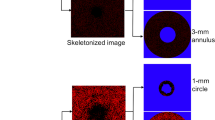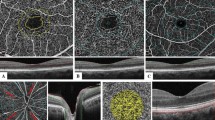Abstract
The aim of the study is to telemedically assess the prevalence of simple optic nerve atrophy and retinal arteriolar anomalies in subjects who have had a minor stroke or TIA within 14 days, and to compare these results with an age-matched control group. By using a mobile examination unit, retinal photographs were taken with a 45° non-mydriatic colour fundus camera (KOWA NM-45, non-mydriatic-alpha) in patients who had suffered from a minor stroke or TIA within 14 days of the time of the examination. Retinal photographs were focused on the optic nerve head region. Pupils were not dilated. The documented medical history and the retinal images were stored on a server using browser independent web-based software running on PCs, tablets and smartphones. After completing the upload of the medical interview and the retinal images into the electronic patient chart, all retinal images were evaluated via telemedicine by an experienced senior consultant ophthalmologist. Age-matched normotensive, non-diabetic subjects (aged 40–89 years) who reported no systemic or ocular diseases were used as the control group. Both study groups were divided into five decades of life (40–49; 50–59; 60–69; 70–79; 80–89 years). We calculated the prevalences and the ratios of prevalences of optic nerve atrophy and retinal arteriolar anomalies between the stroke and the control group per decades of life. 139 minor stroke or TIA subjects (aged 40–89 years) and 1611 age-matched control subjects were examined. In the stroke group, we found significantly increased prevalences of optic nerve atrophy and retinal arteriolar anomalies throughout the 5th–8th decade of life when compared to age-matched controls. The prevalence of optic nerve atrophy in stroke subjects outranged the prevalence in the controls depending on age-class by a factor of 3–21. Simple optic nerve atrophy is frequent in patients who have suffered from an ischemic stroke or TIA, and it seems to indicate vascular damage, indicating the necessity for telemedically assisted assessment of the optic nerve.



Similar content being viewed by others
References
Wong TY, Klein R, Islam FM et al (2006) Diabetic retinopathy in a multi-ethnic cohort in the United States. Am J Ophthalmol 141:446–455
Wong TY, Mitchell P (2004) Hypertensive retinopathy. N Engl J Med 351:2310–2317
Wong TY, Klein R, Couper DJ et al (2001) Retinal microvascular abnormalities and incident stroke: the atherosclerosis risk in communities study. Lancet 358:1134–1140
Wong TY, Mitchell P (2007) The eye in hypertension. Lancet 369:425–435
Wong TY, Hubbard LD, Klein R et al (2002) Retinal microvascular abnormalities and blood pressure in older people: the cardiovascular health study. Br J Ophthalmol 86:1007–1013
Wong TY, Klein R, Klein BE et al (2001) Retinal microvascular abnormalities and their relationship with hypertension, cardiovascular disease, and mortality. Surv Ophthalmol 46:59–80
Klein R (1992) Retinopathy in a population based study. Trans Am Ophthalmol Soc 90:561–594
Klein R, Klein BE, Moss SE (1997) The relation of systemic hypertension to changes in the retinal vasculature: the beaver dam eye study. Trans Am Ophthalmol Soc 95:329–350
Wong TY, Klein R, Sharrett AR et al (2003) The prevalence and risk factors of retinal microvascular abnormalities in older persons: the cardiovascular health study. Ophthalmology 110:658–666
Mitchell P, Wang JJ, Wong TY et al (2005) Retinal microvascular signs and risk of stroke and stroke mortality. Neurology 65:1005–1009
Henderson AD, Bruce BB, Newman NJ et al (2011) Hypertension-related eye abnormalities and the risk of stroke. Rev Neurol Dis 8:1–9
Doubal FN, Hokke PE, Wardlaw JM et al (2009) Retinal microvascular abnormalities and stroke: a systematic review. J Neurol Neurosurg Psychiatry 80:158–165
Baker ML, Hand PJ, Wang JJ et al (2008) Retinal signs and stroke: revisiting the link between the eye and brain. Stroke 39:1371–1379
De Silva DA, Manzano JJ, Liu EY et al (2011) Retinal microvascular changes and subsequent vascular events after ischemic stroke. Neurology 77:896–903
Hayreh SS, Jonas JB (2000) Appearance of the optic disk and retinal nerve fibre layer in atherosclerosis and arterial hypertension: an experimental study in rhesus monkeys. Am J Ophthalmol 130:91–96
Achmed E (2001) A textbook of ophthalmology. Prentice-Hall of India Private Limited, New Delhi, pp 359–361
Hayreh SS, Zimmerman MB (2007) Fundus changes in central retinal artery occlusion. Retina 27:276–289
Leistner S, Michelson G, Laumeier I et al (2013) Intensified secondary prevention intending a reduction of recurrent events in TIA and minor stroke patients (INSPiRE-TMS): a protocol for a randomised controlled trial. BMC Neurol 13:11
Michelson G, Groh M, Groh MJ et al (2005) Telemedical-supported screening of retinal vessels (“talking eyes”). Klin Monbl Augenheilkd 222:319–325
Michelson G, Laser M, Müller S et al (2011) Validation of telemedical fundus images from patients with retinopathy. Klin Monbl Augenheilkd 228:234–238
Paulus J, Meier J, Bock R et al (2010) Retinal microvascular changes and target. Int J Comput Assist Radiol Surg 5:557–564
Jonas JB, Nguyen NX, Naumann GO (1989) Optic disc morphometry in simple optic nerve atrophy. Acta Ophthalmol (Copenh) 67:199–203
Lehmann MV, Schmieder RE (2011) Remodelling of retinal small arteries in hypertension. Am J Hypertens 24:1267–1273
Ritt M, Harazny JM, Ott C et al (2012) Influence of blood flow on arteriolar wall-to-lumen ratio in the human retinal circulation in vivo. Microvasc Res 83:111–117
Boltz A, Schmidl D, Werkmeister RM et al (2013) Regulation of optic nerve head blood flow during combined changes in intraocular pressure and arterial blood pressure. J Cereb Blood Flow Metab 33:1850–1856
Schmidl D, Boltz A, Kaya S et al (2013) Role of nitric oxide in optic nerve head blood flow regulation during an experimental increase in intraocular pressure in healthy humans. Exp Eye Res 116:247–253
Ritt M, Harazny JM, Ott C et al (2011) Basal nitric oxide activity is an independent determinant of arteriolar structure in the human retinal circulation. J Hypertens 29:123–129
Acknowledgments
We would like to thank Gabriele Nieweler, Katrin Haug and Sabine Wunderlich for conducting the digital photographs of the ocular fundus in minor stroke and TIA patients. The present work was performed in fulfilment of the requirements for obtaining the degree “Dr. Med.” from the Friedrich-Alexander-Universität Erlangen-Nürnberg (FAU).
Funding
The authors declare that there has been no funding: this research received no specific Grant from any funding agency in the public, commercial or not-for-profit sectors.
Contributorship statements
Johannes Wolz is the corresponding author. He is responsible for the statistical processing and analysis of the data gained by the Talkingeyes® network. He selected the subjects of the two study groups, conducted the statistical calculations and interpreted the results in the context of existing study results. He drafted all chapters. Professor Dr. Heinrich Audebert is the principal investigator of the INSPiRE-TMS study. He is responsible for the study design of the trial including the integration of fundoscopy, for the collection of the medical data and for the creation of the digital photographs of the ocular fundus of 139 minor stroke and TIA patients. Professor Dr. Georg Michelson is the head of the IZPI. He is responsible for the collection of the medical data and the creation of the digital fundus photographs of 9426 patients in the context of the Talkingeyes® network. He was responsible for the medical evaluation of all images. Dr. Inga Laumeier, Dr. Michael Ahmadi, Dr. Maureen Steinicke and Dr. Caroline Ferse are responsible for the recruitment of 139 minor stroke and TIA patients, the documentation of the medical data and the sending of the digital images of the ocular fundus to the IZPI Erlangen.
Author information
Authors and Affiliations
Corresponding author
Ethics declarations
Conflict of interest
All authors certify that they have no affiliations with or involvement in any organization or entity with any financial interest (such as honoraria, educational grants, participation in speakers’ bureaus, membership, employment, consultancies, stock ownership, or other equity interest, and expert testimony or patent-licencing arrangements) or non-financial interest (such as personal or professional relationships, affiliation, knowledge or beliefs) in the subject matter or materials discussed in this manuscript.
Ethics approval
This analysis is based on data gained by a study group of the Department of Ophthalmology at the University Hospital Erlangen and the Centre for Stroke Research of the Neurological Clinic at the Charité University Berlin, Campus Benjamin Franklin [17]. Ethics approval was obtained by the Ethics Committee of the Charité University Berlin (EA2/084/11). The study was registered with the registry of clinical trials (clinicaltrials.gov: 01586702) and was performed in accordance with the Declaration of Helsinki. All persons gave their informed consent prior to their inclusion in the study.
Rights and permissions
About this article
Cite this article
Wolz, J., Audebert, H., Laumeier, I. et al. Telemedical assessment of optic nerve head and retina in patients after recent minor stroke or TIA. Int Ophthalmol 37, 39–46 (2017). https://doi.org/10.1007/s10792-016-0222-7
Received:
Accepted:
Published:
Issue Date:
DOI: https://doi.org/10.1007/s10792-016-0222-7




